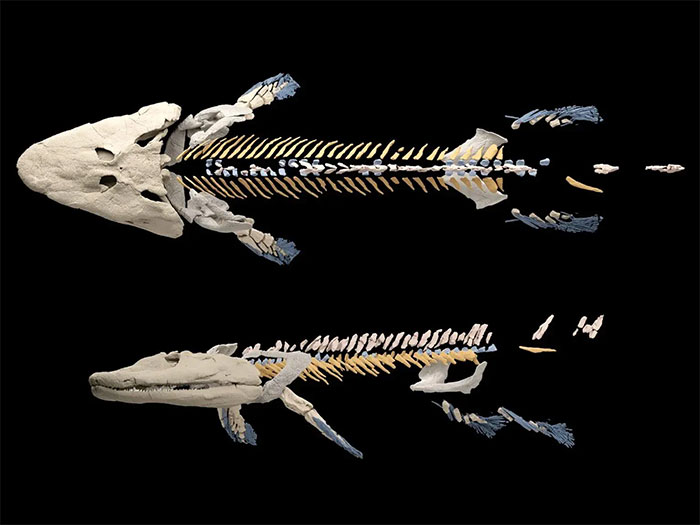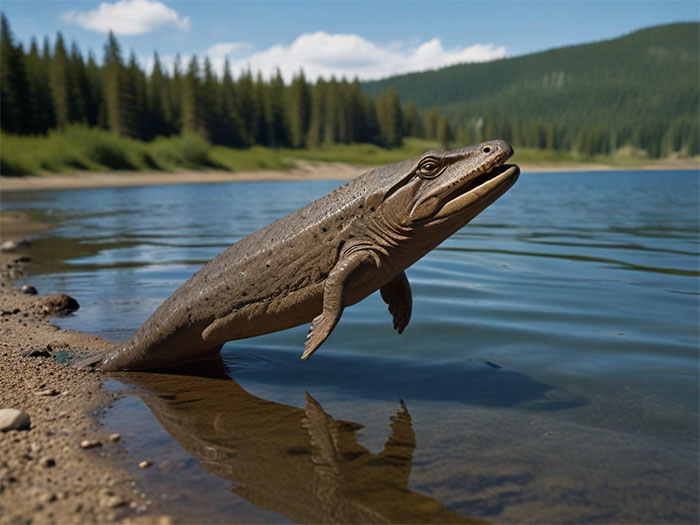A 375-million-year-old sea monster that grows legs reveals the secret to changing the earth
The sea monsters of the Devonian period are evidence of the evolutionary leap that enabled us to walk on continents today .
New findings from sea monster fossils dating back 375 million years provide insight into the evolution of the axial skeleton , shedding light on how our ancestors transitioned from aquatic to terrestrial life.

The bizarre skeleton of the Devonian sea monster Tiktaalik - (Photo: ERBELY UNIVERSITY OF SCIENCE).
According to SciTech Daily, it is a surprisingly intact fossil of a Tiktaalik, an ancient fish often excavated in the Canadian Arctic region.
Using micro-CT scanning, the exquisite details of this Devonian sea monster's vertebrae and ribs have been revealed.
A group of scientists from Erbely University of Science (USA) showed that the ribs of this monstrous fish can be tightly connected to its pelvis with ligaments, something not found in normal fish. . Its pelvic fins also have a tighter connection.
This anomaly was used to support the ability to move on the hind limbs, which is only found in land animals that were born much later than this fish.
In normal fish, the pelvic fins and bones of the pelvic girdle are relatively small and almost "float" freely in the body.
Therefore, Tiktaalik is the species that holds the first step to the terrestrial life of the biological world , which is to gradually develop the ability to walk.
Its fins and pelvis made it wander on land, but helped it "stand up" and propel itself with its hind fins at the water's edge.

Tiktaalik can strangely "stand up" on the water's edge with its pelvic fins used as legs, although much smaller and weaker than the legs of four-legged animals - (AI graphic photo).
To date, researchers have never found a skeleton containing similar evolutionary traces.
"This reconstruction shows for the first time how everything fits together and gives us clues about how walking evolved," said Associate Professor Tom Stewart from the Erbely College of Science.
The complete reconstruction of Tiktaalik's skeleton took researchers many years. Initially only the front body was found and it took them a long time to remove the fossil from the slab.
In 2014, the fish's pelvis was revealed at the same fossil site. After 10 years of dissection and research, its complete skeleton was reassembled and a surprise was revealed.
- Giant 17-meter-long sea monster reveals the secret of 'miracle evolution'
- Loch Ness monster secret secret code
- The constant debate about the 300 million-year-old Tully monster
- Decode secret million years of the most giant monster on Earth
- The 70-million-year-old plesiosaur fossil resembles the Loch Ness monster
- The animal with 50 living parts 550 million years ago could decipher the secret of life
- From fish to humans: The study reveals how the fins have transformed into legs
- Detection of 180 million year old sea monster fossils
- 'Time Gate' reveals the scene of a galaxy containing Earth turned into a monster
- Google Earth reveals the mystery of the
- Digging the 250 million year old sea monster in the American desert
- Loch Ness monster monster objects head up on the lake
 Discovered an ancient centipede fossil 99 million years old
Discovered an ancient centipede fossil 99 million years old Discovered bat-like dinosaurs in China
Discovered bat-like dinosaurs in China Discovered a 200-year-old bronze cannon of the coast
Discovered a 200-year-old bronze cannon of the coast Discover 305 million-year-old spider fossils
Discover 305 million-year-old spider fossils